Alexander Nevsky Cathedral
 Some statue of a guy on a horse.
Some statue of a guy on a horse. Another cool looking statue.
Another cool looking statue. Some cool looking building.
Some cool looking building. Sports arena.
Sports arena. Advertisement. I'm not really sure what they are advertising. I can't tell if it is watermelon that is being advertised or if it's some kind of metaphor. It's a bit racy, but fairly representative of European norms.
Advertisement. I'm not really sure what they are advertising. I can't tell if it is watermelon that is being advertised or if it's some kind of metaphor. It's a bit racy, but fairly representative of European norms.
Many these countries use the Cyrillic alphabet. Bulgaria seemed to have less signage in English than many of the countries I've traveled in. Reading maps is difficult unless the streets are labeled with both English and the local language. An English-only map is useless because the street signs are in Cyrillic. A local language map is useless because it's impossible to pronounce the names of anything written in the local language. When traveling by train or bus, one has to know both. Below are them names of places in Bulgaria (България) that I visited:
Sofia - София
Plovdiv - Пловдив
Veliko Tarnovo - Велико Търново
My train ticket from Sofia to Plovdiv.

I liked the Train station in Sofia. It had an old school communist-era vibe.


On July 10 I took a train to Plovdiv, The City of Seven Hills. Plovdiv dates back 6,000 years and is one of the oldest, continually inhabited cities in the world. Plovdiv was a beautiful city.







 It had a Roman Stadium and a Roman Amphitheater, both dating back to the 2nd century.
It had a Roman Stadium and a Roman Amphitheater, both dating back to the 2nd century.

From what I've read, twenty years ago, commerce in Bulgaria was quite different. In the Communist days, people had money, but nothing to buy. People would line up for hours to buy staples and basic stuff. My experience walking the streets of Plovdiv was that the opposite was true. There were tons of stores lining the streets selling the latest fashions, but they were almost completely empty, with the shopkeepers sitting outside on the front steps smoking and talking with the other shopkeepers. It seems like there are tons of things to buy, but no-one was buying anything.
I would have liked to have spent more time in Plovdiv, it was a really cool town, but there was no one else at the hostel I was staying at. I didn't really see any tourists (at least English-speaking) walking around or in the pubs. I only spent two nights in Plovdiv and then I took a train to Veliko Tarnovo.
The train station in Plovdiv.
 It was pretty small.
It was pretty small. Pics of sunflower fields taken on the train from Plovdiv to Veliko Tarnovo. The Bulgarian countryside was very nice.
Pics of sunflower fields taken on the train from Plovdiv to Veliko Tarnovo. The Bulgarian countryside was very nice.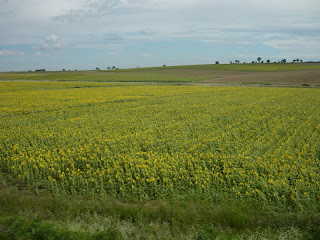

 On July 12 I arrived in Veliko Tarnovo. It was a charming town nestled in a steep valley. There was a castle on a hill.
On July 12 I arrived in Veliko Tarnovo. It was a charming town nestled in a steep valley. There was a castle on a hill.




 On July 16, I took an overnight train from Veliko Tarnovo to Bucharest, Romania.
On July 16, I took an overnight train from Veliko Tarnovo to Bucharest, Romania. Since I would be coming back to Bucharest to fly to Madrid, I didn't want to stay there so I decided to go on to Brasov. It was still pretty early in the morning. Getting cash in Romania proved to be the most difficult of all places I'd been. I heard people say they had trouble getting cash out of ATMs in all of Eastern Europe using cards from western banks due to the level of fraud. But I had no trouble at all until getting to Romania. I finally found an ATM that would work with one of my cards so I took out a bunch of cash, went back to the train station and caught the next train to Brasov, the capital of the Transylvania region.
Since I would be coming back to Bucharest to fly to Madrid, I didn't want to stay there so I decided to go on to Brasov. It was still pretty early in the morning. Getting cash in Romania proved to be the most difficult of all places I'd been. I heard people say they had trouble getting cash out of ATMs in all of Eastern Europe using cards from western banks due to the level of fraud. But I had no trouble at all until getting to Romania. I finally found an ATM that would work with one of my cards so I took out a bunch of cash, went back to the train station and caught the next train to Brasov, the capital of the Transylvania region.One good thing about being in Romania was a return to the Roman alphabet. The signs were easier to comprehend. The Romanian language originated from Latin, like Spanish, French, and Italian. This is a bit unusual geographically, with Romania being surrounded by Slavic countries.
I took the 2.5 hour train ride from Bucharest to Brasov. Brasov is another cool town and is the home base for traveling in the Transylvania region. Their motto is, "Brasov, Probably the Best City in the World."





On July 19 I took a castle tour.





 Transylvania has only a loose connection to Dracula. The below pic is of Castle Bran, also known as Dracula's Castle. Bram Stoker, author of Dracula, was an Englishman who never visited Romania. He had read about a charming Romanian Prince named Vlad the Impaler, who ruled with an iron fist and savagely brutalized his enemies by impaling them. Impaling involves inserting a long spike into the anus, through the torso, and, out the mouth, and leaving the person to die. Vlad's method of impaling was particularly painful because it was done without piercing the vital organs. If a vital organ was pierced, the victim would go into shock and die quickly. Vlad's method produced a slow, painful death.
Transylvania has only a loose connection to Dracula. The below pic is of Castle Bran, also known as Dracula's Castle. Bram Stoker, author of Dracula, was an Englishman who never visited Romania. He had read about a charming Romanian Prince named Vlad the Impaler, who ruled with an iron fist and savagely brutalized his enemies by impaling them. Impaling involves inserting a long spike into the anus, through the torso, and, out the mouth, and leaving the person to die. Vlad's method of impaling was particularly painful because it was done without piercing the vital organs. If a vital organ was pierced, the victim would go into shock and die quickly. Vlad's method produced a slow, painful death.
Castle Bran was the castle of his brother. There is no evidence or even likelihood that Vlad ever set foot in this castle, but it is the closest thing to a Dracula's Castle for tourists to visit. The Romanian people embrace their Dracula connection, or at least the people who sell Dracula related merchandise do.




Another castle on the tour. Some actors act out what I assume is a traditional Romanian play.

One of the little things that really crack me up about traveling is the way some signs and menus get less than stellar translations to English. This menu at a little restaurant in Brasov is a good example. It covers the cute (Trout in the Frying Pan), to the funny (Fried Crap), to the accurate but not very appetizing literal translation (Salt and Vegetable Dressing). There were tons of examples of this all over the world.

On July 20, I took a train from Brasov to Bucharest, the capital of Romania. I had heard nothing but bad things about Bucharest. I heard it was nasty, dangerous, and there were stray dogs everywhere. If I hadn't heard all these things, I would probably have thought a lot less of Bucharest, but given my low expectations, I didn't think it was all that bad.




 I took a tour of the Palace of Parliament. The Palace was built in the 1980's under President Nicolae Ceausescu. A huge swath of the city's historic center was demolished to build this monstrosity of a building. It is the second largest building in the world after the Pentagon.
I took a tour of the Palace of Parliament. The Palace was built in the 1980's under President Nicolae Ceausescu. A huge swath of the city's historic center was demolished to build this monstrosity of a building. It is the second largest building in the world after the Pentagon. These steps were built and rebuilt five times to get them to Ceausescu's exacting specifications.
These steps were built and rebuilt five times to get them to Ceausescu's exacting specifications.





 If I'm a little light on details about Bulgaria and Romania it's probably a combination of not really that much out of the ordinary happening and the amount of time that has passed since I was there. One night in Brasov me and about five guys took a girl out for her birthday. I don't remember her name (she was from Los Angeles), or the guys (one was from Australia and two from England), but we had a really good time. She did not know any of us before that day. Brasov had some pretty cool bars and nightclubs. I didn't tell anyone it was my birthday back in February, mostly because I had just gotten in to Australia the day before and slept most of the day because of the jet lag.
If I'm a little light on details about Bulgaria and Romania it's probably a combination of not really that much out of the ordinary happening and the amount of time that has passed since I was there. One night in Brasov me and about five guys took a girl out for her birthday. I don't remember her name (she was from Los Angeles), or the guys (one was from Australia and two from England), but we had a really good time. She did not know any of us before that day. Brasov had some pretty cool bars and nightclubs. I didn't tell anyone it was my birthday back in February, mostly because I had just gotten in to Australia the day before and slept most of the day because of the jet lag.On July 22, I flew from Bucharest to Madrid, Spain. Spain was hot. Damn hot.






 Spaniards love their ham. It can usually be seen hanging in the stores and restaurants with the hoof attached.
Spaniards love their ham. It can usually be seen hanging in the stores and restaurants with the hoof attached. I went to the Bilbao museum one day. I did some other stuff too, but I'm drawing a blank on the details.
I went to the Bilbao museum one day. I did some other stuff too, but I'm drawing a blank on the details.Madrid is a lively city. Spain is a late night town. People don't eat dinner until after 10:00. I even saw a lot of old people out after midnight in bars and outdoor restaurants.
 One thing I really wanted to do in Spain was go to a Bullfight. In South America I seemed to always be just missing the bullfighting season in whatever country I was in. In Spain, it was a bit of an off-season, but there was still a fight. The Sunday night bullfight in Madrid featured younger bullfighters and only cost 5 Euros (Yes!!!). I was having trouble finding someone to go to the bullfight with me. No one at the hostel wanted to go see a bullfight. It was easier to find a date to go to a prison in Bolivia than to find someone to go to a bullfight in Madrid. Finally I met John from Texas who wanted to go. He was raised in Texas and moved to Scotland when he was fifteen. He had the craziest accent I ever heard.
One thing I really wanted to do in Spain was go to a Bullfight. In South America I seemed to always be just missing the bullfighting season in whatever country I was in. In Spain, it was a bit of an off-season, but there was still a fight. The Sunday night bullfight in Madrid featured younger bullfighters and only cost 5 Euros (Yes!!!). I was having trouble finding someone to go to the bullfight with me. No one at the hostel wanted to go see a bullfight. It was easier to find a date to go to a prison in Bolivia than to find someone to go to a bullfight in Madrid. Finally I met John from Texas who wanted to go. He was raised in Texas and moved to Scotland when he was fifteen. He had the craziest accent I ever heard.Bullfighting is a bloody sport and I can can see how it would freak a lot of people out. The bull comes out and spends some time charging the Matador's team members. This is just simple charging with the team members holding pink capes. The matador is the only one who uses red. Then a guy comes out on an armored, blindfolded horse. The bull will charge the horse and the guy on the horse jabs a long spear a few times into the bull's back. The bull looses quite a bit blood and is weakened. Then the picadors come out. The bull charges the picadors and as it passes them, they get out of the way and jab two spears into the bulls neck. This weakens the bull further. After three passes (six spears) the Matador comes out and fights the weakened bull. After the bull charges the matador about a 15-20 times, the matador takes out his sword and sticks it into the bull's neck, killing the bull. The bull's carcass is dragged out of the ring by a horse cart and men come out and scoop dirt to cover the bloody spot. The process is repeated five more times (2 times per matador). It got a bit repetitive after the second fight.
Bullfighting is a judged sport. If the matador does a good job, he gets the bull's ear as a trophy. If he does an outstanding job, he gets both ears. If he does a superb extraordinary job, he gets both ears and the tail. If the matador sticks his sword into the bull properly, it will kill the bull instantly. This is desirable in the scoring. As mentioned earlier, these were young bullfighters. One of them was only 19 years old. He looked like a little kid. None of them got to keep any parts of the bull this night. In fact, one of them took four stabs to finally kill the bull. Blood gushed out the bull's mouth. The crowd was not pleased.
Plaza de Toros.
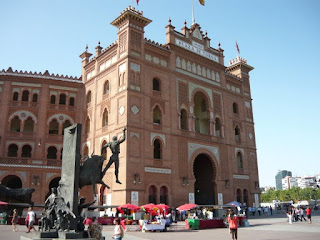










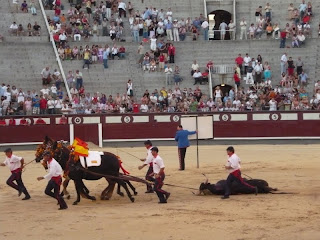






Although I was pleased with the low price of the ticket, it ended up costing me quite a bit more. Either at the fight or on the subway on the way back, I got pick pocketed. Luckily I had taken out my ATM cards and credit cards, but I lost about 100 Euros and my drivers license. This would be the last time I would be robbed on the trip.
The next day I took a train to Sevilla. Spain has a very fast and efficient (if a bit pricey) train system.
Plaza de España. Some scenes of Star Wars Attack of the Clones were filmed here, but were digitally modified in the movie.


Typical Sevillan street.

The Alacazar.

The Cathedral.

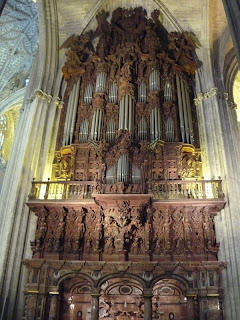





Some miners were holed up in the cathedral on strike. I'm really not sure why they were in the cathedral. They kind of kept to themselves and didn't bother the tourists.


The Plaza de Toros.


Nighttime in Sevilla.



On July 28, I went to see The Boss at La Cartuga Olympic Stadium. I kind of planned my trip around this. I wanted to go to Spain and I wanted to go to Sevilla anyway, so I planned the timing around this show. I went with three Brits I'd met who were spending their holiday following The Boss around Italy and Spain. This had to be one expensive holiday. The general admission ticket was 75 Euros ($108). This is the most I've ever spent on one concert ticket. I don't know if it was worth 75 Euros, but it was a pretty damn good show.

The stadium was not completely sold out, but it was pretty close.
 Urinals for men in the back of the floor area. Europeans are quite a bit less modest about urinating in public than Americans.
Urinals for men in the back of the floor area. Europeans are quite a bit less modest about urinating in public than Americans. The show was pretty damn good. This was my first time to see Bruce, so I was pretty pumped. He came to Nashville on August 21, 2008, exactly four days after I started this trip. This show was announced after I bought my ticket and paid for my Spanish school. Putting off the trip to catch this show wasn't really an option.
The show was pretty damn good. This was my first time to see Bruce, so I was pretty pumped. He came to Nashville on August 21, 2008, exactly four days after I started this trip. This show was announced after I bought my ticket and paid for my Spanish school. Putting off the trip to catch this show wasn't really an option.I think Bruce learned about three or four phrases in Spanish and repeated them over and over again. At the beginning he yelled out "Ola Sevilla!" about ten times. When he introduced the band he yelled "El Hombre Grande!" about five times. The Brits I was with said the set lists were better in Rome and Bilbao, but I was happy.


As true with Spanish culture the show started late, lasted until well after 1:00am, and people all seemed to have a killer time. I wonder where the Spanish get their money (75 Euro concert tickets and 8 Euro beers) and their energy (late night concert on a Tuesday night).


Sevilla was extremely hot. In the afternoons it would regularly get up to about 110 degrees. The siesta is strictly observed. Businesses close down from about 2:00 to about 5:00. Everyone goes home to escape from the heat and to take a nap. Businesses open back up around 5:00 and stay open until about 7:00 or 8:00. Dinner is usually eaten between 10:00 and midnight.
On July 30, I took a took a Ryanair flight from Madrid to Dublin, Ireland, my last country before returning home. Ryanair is one of, if not the largest discount carrier in Europe. Discount airlines in Europe advertise tickets for ridiculously cheap prices. Sometimes as low as a few Euros per ticket. When I booked my ticket, the initial fare for the one-way ticket was 15 Euros. As I clicked through the screens, it seemed like each click cost me more money. 18 Euros for taxes. Five Euros for an online check-in fee. Ten Euros for a checked bag. Five Euros to for a payment fee (I basically had to pay a fee to pay for the ticket). All told, my 15 Euro ticket ended up costing me over 50 Euros.
Ryanair really is the bottom of the barrel for flying. Some people think flying on Southwest is slumming it, but Ryanair takes the cake. The seat pockets have been removed to make more room for more rows of seats. The doors to the overhead bins are plastered with advertisements. There was a soccer team on board and they screamed soccer soccer chants for the whole three hours.
It was almost midnight when I got into Dublin. I handed my passport to the customs agent and he looked it over. By this time, my passport was quite full. I had just enough space for a European Union sized stamp to enter Ireland and a stamp to get back into America. The customs agent told me there wasn't any space left in my passport. I pointed to a spot on a page. He then proceeded to chow me the Irish stamp, which was different from the standard EU sized stamp. It took up almost an entire page, which I didn't have. He flipped through it again and told me that without sufficient space for a stamp, it was not a valid document. I didn't know what to say other than to beg for him to "be cool". He flipped through it one more time and stamped the back flap, which was totally not an authorized visa page, and let me pass. When I got back to the states I sent my passport off to have more pages attached so I could travel again some day.
The next morning I took a walking tour of Dublin.
Trinity College.
 Dublin Castle, which was not a castle at all.
Dublin Castle, which was not a castle at all. Sand sculptures near Dublin Castle.
Sand sculptures near Dublin Castle.

Some churches - St something or other. There were two big ones in Dublin. Both charged 10 Euros each to go inside. By this point on my trip I had been in enough churches and didn't deem these two to be worth 20 Euros.




This building was formerly a warehouse that was a music venue in the 70's and 80's. It is one of the venues where U2 got their start and built their following.

Pubs, pubs, and more pubs.



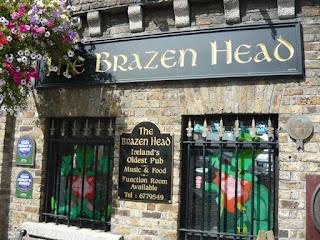


No better sight than a settling Guinness.

I was really looking forward to my first pint of Guinness. I've heard that a Guinness in Ireland tastes totally different from a Guinness in the states. I really couldn't tell a difference, but it had been over a year since I'd had a Guinness in the states. I had wanted to spend a good bit of my time in Ireland in drinking myself silly in pubs. But at 4.50 Euros a pint, I would only be able to drink myself mildly amusing.

 Ireland is a crazy expensive country. A simple meal like fish and chips or Irish stew would be at least 10 Euros. A nicer dinner would be 25 Euros if you made the early bird special. The money I saved by traveling in Asia was spent in Western Europe.
Ireland is a crazy expensive country. A simple meal like fish and chips or Irish stew would be at least 10 Euros. A nicer dinner would be 25 Euros if you made the early bird special. The money I saved by traveling in Asia was spent in Western Europe.Bridges over the River Liffey.




 Doors of Dublin.
Doors of Dublin.

Spire of Dublin.

The Guinness Brewery.



I had four days in Dublin, which was probably a little much for Dublin, but not really enough to get in another location. Dublin is a lot of fun, but it's really not a very attractive city. I wanted to get out and see the Irish countryside. On the advice of a fellow traveler, I decided to go hiking in County Wicklow.
It seemed an easy day trip from Dublin. I took the DART (Dublin Area Rapid Transit) to the last station Greystones and hiked to Bray, the next to last station. This was a good hike and a great way to see the Irish countryside, even if I did get a little lost along the way.


I hike up a mountain/hill on a marked path. The marked path to the top was pretty straight forward. I wanted to go down a different way. So instead of turning around at the top of the hill, I just kept on walking. I figured if I kept going down the hill, I would eventually end up in Bray. It's not like it is in the US. Ireland is a small country and the chances of walking for a day, or even a few hours without running into a town, were small. I did go through some shady looking paths and climbed a few fences.

Passed several sheep farms.

I passed a farm house, after which a paved road started. A car was outside, and some kids were out playing in the back yard, but I kept on going. I came up on a motorized gate. I couldn't get around it or over it. I had to wait for a car to come by, which thankfully only took about 15 minutes.
The countryside was absolutely gorgeous. Keep in mind that I am not a good photographer and have a very basic digital camera.














It was closing in on the last day of my trip. I was growing weary of traveling, but I wanted to do something on my last day and night. During the day, I took the DART to Howth, a charming little fishing village on the last stop on the other end of the line.



 That night I went on a literary pub crawl. Ireland has a great literary tradition (Wilde, Joyce, Shaw, Yeats, etc.) and many of the pubs where they drank themselves to death are still in business. Two Irish actors took a group of about 20 on a tour of five pubs. At each one they acted out works of Ireland's famous authors. It was a very entertaining look at that part of Dublin's history.
That night I went on a literary pub crawl. Ireland has a great literary tradition (Wilde, Joyce, Shaw, Yeats, etc.) and many of the pubs where they drank themselves to death are still in business. Two Irish actors took a group of about 20 on a tour of five pubs. At each one they acted out works of Ireland's famous authors. It was a very entertaining look at that part of Dublin's history.On the morning of August 4, I took a bus to the airport. I was going home.



